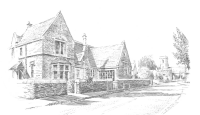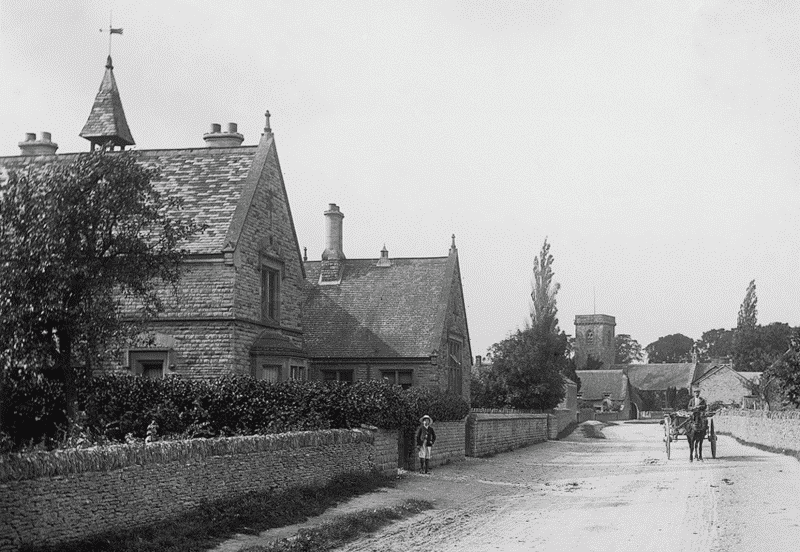 |
Brize Norton Primary School - Victorian Historybelonging, learning and succeeding |
|
 |
Brize Norton Primary School - Victorian Historybelonging, learning and succeeding |
|
|
|
|
Extract from the Victorian History Society www.british-history.ac.uk/vch/oxon/vol15/pp205-218  78. Brize Norton school and church in the late 19th century Education Education to 1874 Goddard Carter of Alvescot, by will proved 1725, left a rent charge of £5 from lands in Brize Norton (Marsh Haddon farm) to pay someone to teach poor children living in the parish to read, write, and do some arithmetic. The persons responsible for paying the charge were to appoint both teacher and pupils. (fn. 225) By 1738 a 'free school' had been established which was supervised by two of Carter's sons-in-law as trustees. (fn. 226) By 1759 the governorship had passed to the vicar and churchwardens of Brize Norton. Ten boys or girls were now educated, (fn. 227) implying the practice recorded from 1793 whereby the governors chose eight children for admission and the schoolmaster two. (fn. 228) By 1808 two private schools also existed, respectively teaching 20 children to read, write, and do arithmetic and 10 children only to read. (fn. 229) Both closed by 1815. There was then no Sunday school and the teacher at the endowed school was over 60 and unwilling to adopt the new National Plan. (fn. 230) By 1824 the schoolmistress no longer taught writing, though all children learnt to read and girls were also taught knitting and sewing. Children generally stayed at school until they were 10 or 12 years old. (fn. 231) In 1819 education for the poor of Brize Norton had been deemed insufficient, (fn. 232) but in 1831 most of the village children not at the endowed school were allegedly being educated at their parents' expense. (fn. 233) A Sunday school was started in 1833, which initially recruited 39 boys and 36 girls aged 6 or older who paid 1d. a week for books. The vicar also lent or gave to parishioners tracts produced by the Society for the Promotion of Christian Knowledge. In 1835 the endowed school additionally educated 20 fee-payers and another school had 22 pupils who all learnt reading and writing. (fn. 234) In 1860 three small schools, presumably including the endowed school, were reported but were judged by the vicar to be 'little better than dame schools. . . . affording very insufficient education'. (fn. 235) The endowed school continued after a board school opened in 1876, but in 1883 its former mistress was described as mistress of a dame school, which suggests that the endowed school had ceased. (fn. 236) Attempts were made to found a Church school from 1856 when the curate, Joseph Halifax, approached Christ Church, Oxford, for assistance. In 1860 the new vicar, George Fereman, reported that Sir Edward PageTurner, a major landowner, had promised a site if building money could be raised. Fereman continued to seek funds and in 1870 obtained the offer of a site and financial contribution from Christ Church. (fn. 237) But his efforts to provide a school proved unsuccessful. Brize Norton School from 1874 In 1874 a school board was formed, (fn. 238) and a school was built by Joseph Timms with stone from his family's quarry. (fn. 239) Designed in picturesque Tudor Gothic style, with rock-faced stone walls and a red clay-tiled roof, the school opened on 8 May 1876 and could accommodate 123 children. It was planned with a large schoolroom linked to the teacher's house by a smaller room. There was room for three classes in the schoolroom and infants could meet in the other room. (fn. 240) Attendance was initially low: in 1878 only an average of 15 attended who were taught by one master. It improved to 58 by 1880, (fn. 241) to 87 by 1883, (fn. 242) to 99 by 1903, and to 105 by 1907. (fn. 243) In 1891 the school received an annual government grant of £155, a fee grant of £83, and voluntary contributions of £53. (fn. 244) A scheme of that year converted Goddard Carter's endowment into a charity for providing prizes or rewards for poor scholars. (fn. 245) School leavers were later given 12s. 6d. each, which was often spent on clothes for agricultural work or domestic service. (fn. 246) In 1926 a proposed reorganization as a junior school was rejected because the managers expected Nonconformist parents to oppose the transfer of older children to a Church school. (fn. 247) The headmaster c. 1930 was L. S. R. ('Boss') Jones, an enthusiast who created a prizewinning choir and also organized a recorder band, plays, and dancing. (fn. 248) From 1932 senior children attended Bampton School or Burford Council School, leaving Brize Norton to cater for infants and juniors. (fn. 249) Numbers fell and fluctuated between 36 in 1935, 40 in 1937, and 33 in 1940. (fn. 250) In 1939–40 the school was joined by 37 evacuees and 3 masters from East Ham (London). A school canteen was opened in 1943. (fn. 251) After the Second World War, despite the emigration of agricultural workers, numbers rose as Brize Norton airbase was developed. (fn. 252) In 1949, 22 of 62 pupils came from Carterton and the infant department was overcrowded. Pressure was relieved later that year with the expansion of Carterton school. (fn. 253) In 1950, 27 juniors and 16 infants attended Brize Norton school, which was described as 'alive and forward-looking'. (fn. 254) In 1957–8 a large window was inserted in the south wall of the schoolroom, and toilets and a cloakroom were added to the back; old outside toilets were demolished. (fn. 255) Numbers increased to 45 by 1967 and 70 in 1970. (fn. 256) In 1971 a classroom for infants was built at the back, included with the toilets and cloakroom under a single flat roof. The teacher's house was incorporated into the school c. 1994, and a rendered, portable classroom was installed across the rear playground c. 1996. In 2002 a stone outbuilding associated with the house was converted into a room for design and technology, and music. (fn. 257) In 2001 there were 83 children on the school roll. (fn. 258) Goddard Carter's rent charge was redeemed in the 1940s by the RAF and reinvested in c. £136 of 3½ per cent War Loan stock. The income of £4 15s. 4d. went undistributed for many years, generating a balance of c. £44 by 1966. (fn. 259) In 1976 funds from the Carter charity were used to provide each school-leaver with a Bible. (fn. 260) The charity was closed in 2003. (fn. 261)
|